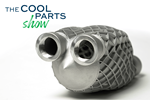Scroll to unlock this premium content if video does not play.
While 3D printing is often applied to heat exchangers as a means of improving performance through geometry, there is another compelling reason to print these devices: material freedom. A project undertaken at Carnegie Mellon University sought to demonstrate the viability of additive manufacturing for producing heat exchangers used by the solar energy industry, which frequently operate at temperatures above 850ºC and pressures as high as 200 atmospheres. In this episode, we speak with Dr. Tony Rollett about demonstrator parts developed at CMU and produced through laser powder bed fusion from Haynes 230 and 282, two nickel-based alloys with creep resistance suitable to this application. | This episode of The Cool Parts Show is sponsored by Carpenter Additive
The Cool Parts Show is a video series from Additive Manufacturing Media that explores the what, how and why of unusual 3D printed parts. Watch more here.
Have a cool part to share? Email us.
Related Resources
- The Cool Parts Show episode featuring spacer grids for holding fuel rods used in nuclear power, also developed at Carnegie Mellon University
- A playlist of other videos about heat exchangers
- All of our heat exchanger stories
- More on additive manufacturing at Carnegie Mellon University
- A company that specializes in 3D printing of a different challenging metal: tungsten rhenium
Transcript
Coming soon
Related Content
-
DMG MORI: Build Plate “Pucks” Cut Postprocessing Time by 80%
For spinal implants and other small 3D printed parts made through laser powder bed fusion, separate clampable units resting within the build plate provide for easy transfer to a CNC lathe.
-
Possibilities From Electroplating 3D Printed Plastic Parts
Adding layers of nickel or copper to 3D printed polymer can impart desired properties such as electrical conductivity, EMI shielding, abrasion resistance and improved strength — approaching and even exceeding 3D printed metal, according to RePliForm.
-
3D Printed Titanium Replaces Aluminum for Unmanned Aircraft Wing Splice: The Cool Parts Show #72
Rapid Plasma Deposition produces the near-net-shape preform for a newly designed wing splice for remotely piloted aircraft from General Atomics. The Cool Parts Show visits Norsk Titanium, where this part is made.


.jpg;width=70;height=70;mode=crop)







